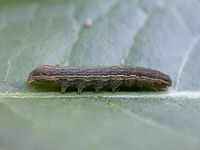| Small square-spot | |
|---|---|

| |
| Scientific classification | |
| Domain: | Eukaryota |
| Kingdom: | Animalia |
| Phylum: | Arthropoda |
| Class: | Insecta |
| Order: | Lepidoptera |
| Superfamily: | Noctuoidea |
| Family: | Noctuidae |
| Genus: | Diarsia |
| Species: | D. rubi |
| Binomial name | |
| Diarsia rubi (Vieweg, 1790) | |
| Synonyms | |
| |
The small square-spot (Diarsia rubi) is a moth of the family Noctuidae. The species was first described by Karl Friedrich Vieweg in 1790. It is found in Europe apart from the far south-east then east through the Caucasus, Transcaucasia, Central Asia, Siberia, the Russian Far East and Kamchatka.

Description
For a key to the terms used, see Glossary of entomology terms.This is a quite a small species (wingspan 30–38 mm) with dull greyish-pink forewings, varying to red brown, marked with a pale angular mark which gives the species its common name. Forewing with the crosslines and shades olive; the cell brown; reniform with whitish outline; claviform with a dark speck at its end; marginal area dark. The hindwings are pale luteous grey with a pink fringe.
Biology
Two broods are produced each year with the adults flying in May and June and again in August and September. Moths of the second brood are usually smaller and darker than those of the first. The species flies at night and is attracted to light and sugar. It will also visit flowers such as heather and ragwort.
The larva feeds on a variety of plants: Recorded food plants include raspberry, Vaccinium and willow. The species overwinters as a larva.
Similar species
Diarsia rubi is difficult to certainly distinguish from its congeners. See Townsend et al.
- Protolampra sobrina (Duponchel, 1843)
- Diarsia mendica ssp. mendica (Fabricius, 1775)
- Diarsia mendica ssp. thulei (Staudinger, 1891)
- Diarsia mendica ssp. orkneyensis (Bytinski-Salz, 1930)
- Diarsia florida (Schmidt, 1859)
References
- Seitz, A. Ed., 1914 Die Großschmetterlinge der Erde, Verlag Alfred Kernen, Stuttgart Band 3: Abt. 1, Die Großschmetterlinge des palaearktischen Faunengebietes, Die palaearktischen eulenartigen Nachtfalter, 1914
- The flight season refers to the British Isles. This may vary in other parts of the range.
- Robinson, Gaden S.; Ackery, Phillip R.; Kitching, Ian J.; Beccaloni, George W.; Hernández, Luis M. (2010). "Search the database - introduction and help". HOSTS - A Database of the World's Lepidopteran Hostplants. Natural History Museum, London.
- Martin C. Townsend, Jon Clifton and Brian Goodey (2010). British and Irish Moths: An Illustrated Guide to Selected Difficult Species. (covering the use of genitalia characters and other features) Butterfly Conservation.
- Chinery, Michael (1986, reprinted 1991). Collins Guide to the Insects of Britain and Western Europe.
- Skinner, Bernard (1984). The Colour Identification Guide to Moths of the British Isles.
External links
- Kimber, Ian. "73.334 BF2123 Small Square-spot Diarsia rubi (Vieweg, 1790)". UKMoths. Retrieved 10 July 2019.
- Savela, Markku. "Diarsia rubi (Vieweg, 1790)". Lepidoptera and Some Other Life Forms. Retrieved 10 July 2019.
- Lepiforum e.V.
| Taxon identifiers | |
|---|---|
| Diarsia rubi |
|